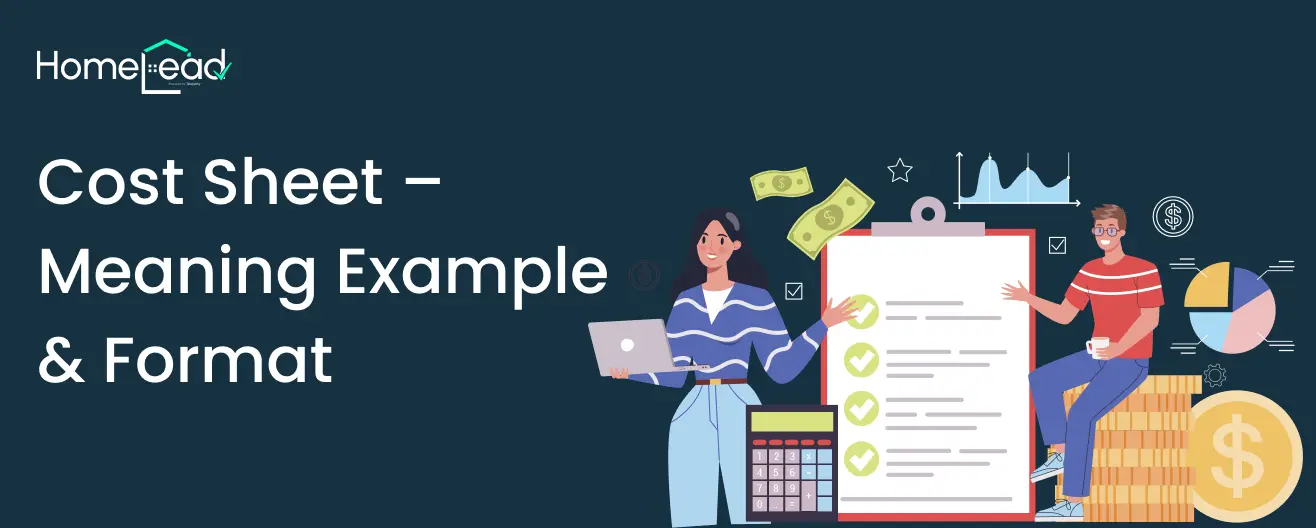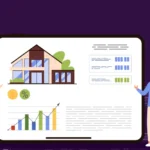
Are you planning a road trip anytime soon? Plan smartly by mapping your path and calculating the fuel costs. Next, determine the distance and estimate travel time. Also plan the places for stopovers before you start your trip. Your budget should include the cost of snacks. This will help you avoid surprises and work within your planned budget to reach the destination easily.
Running a business works in the same way. This is where the cost sheet comes in. A cost sheet acts as a financial roadmap, reducing the costs incurred in producing a product or providing a service. It includes various aspects of running a business, such as raw materials, labor, and overhead costs.
More than merely a list of numbers, a cost sheet serves as a powerful decision-making tool. It helps you set competitive prices and identify cost-saving opportunities. Moreover, you can improve the profitability of the business by identifying cost saving opportunities.
In this blog, we will explore what a cost sheet is, its importance, types, components, and the correct format. We will also show you an example of how a cost sheet appears. This guide will help all business owners, students, or finance enthusiasts learn how to prepare cost sheets. We will delve into analyzing costs efficiently and making better financial decisions.
What is a Cost Sheet?
A cost sheet is a report of all expenses incurred in manufacturing a product or service within a given duration of time. It includes all the elements of expenditure, such as raw materials, labor and factory overheads. This gives a clear picture of the total cost of production.
A cost sheet is not only important in order to record expenses but also to assist businesses in analyzing, controlling, and managing costs effectively. A cost sheet provides transparency on the utilization of resources. This helps to make better decisions on areas such as pricing, budgeting, and profit planning.
It can also be used as a useful source of information by comparing present costs with the previous data. This helps you find trends and identify opportunities to streamline operations. Finally, an effective cost sheet can assist businesses in setting a fair selling price, being profitable, and staying economically sustainable.
Significance and Purposes of Cost Sheet
A cost sheet is more than an accounting record. It is a management tool that aids in essential business processes from cost control to strategic planning. When companies understand the meaning of a cost sheet and its fundamental purposes, it will assist them in achieving financial clarity. This clarity helps improve business performance, especially in competitive markets.
Important Objectives of a Cost Sheet
Determining Cost:
The purpose of a cost sheet is to come up with the actual cost of creating a good or service. It is a list of all the cost elements. It gives you overall cost of production, as well as the unit cost. Such precision is necessary in regular financial planning.
Fixing Selling Price:
It is important that you are aware of all the production costs before you make the decision on what to sell it for. With an appropriate cost sheet format, companies can fix competitive and profitable prices. These prices will be transparent to both the management and the purchasers.
Cost Comparison:
Cost sheets enable you to make comparisons of the current costs of production with the past costs. This assists the managers in identifying the rising costs, tracking trends, and undertaking immediate measures.
Cost Control:
Frequent preparation of cost sheets is important to ensure that all the expenses on labor, material, and overhead are tracked. This proactive tracking helps in saving costs and optimizing resources at all the levels of production.
Decision-Making:
Cost sheets help businesses decide whether to make or buy a part or prepare tenders. They also assist in evaluating new investments to guide strategic financial decisions. Expansion, pricing, or inventory decisions are strategic and are based on information provided in the cost sheet.
Budgeting & Forecasting:
With an estimate of all expenses, it is easier to create correct budgets. Cost sheets provide a financial roadmap that helps to forecast the expenses and guide the business for further expansions.
Regulatory Compliance & Transparency:
Cost sheets allow Indian businesses to be compliant with financial regulations (such as GST and Ind AS). They will also create stakeholder trust through clear cost information, which is significant in audit and investor relations.
Why is a Cost Sheet Important?
Cost sheet is an important tool to control costs in a business and set an accurate selling price. A detailed breakdown of business expenses helps in making informed decisions. Let’s understand the key reasons for incorporating cost sheet in your business:
Pricing Decisions:
A cost sheet reveals the true cost of goods or services. It makes it easier to charge fair and profitable prices that are needed to remain competitive.
Cost Control and Reduction:
Providing a breakdown of expenses, cost sheets can show areas that businesses may be spending excessively on. It helps in reducing expenses and making their businesses efficient.
Profit Analysis:
Periodically utilizing cost sheets can assist in tracking whether the business is making the profits it should. If not, then you must revise pricing, sourcing, or operations.
Budgeting and Financial Planning:
The cost sheets help prepare future budgets by providing financial forecasts that are realistic and reliable. These forecasts are based on actual data, not simply guesses or estimates.
Openness and Communications:
It is appreciated that lenders, auditors, and stakeholders have clarity. Cost sheets are clear evidence of financial discipline, which creates confidence within and outside the firm.
Comparability:
You can compare costs across periods, products, or with industry standards using a standard cost sheet format. By following this format, you can chalk out a smart financial strategy.
Cost sheet preparation provides owners and management with a great platform for decision-making, compliance, and expansion. So, it is one of the key elements of financial practices in the Indian and global environment.
Types of Cost Sheets
A cost sheet is a versatile instrument that is adjusted to fit various business requirements in different sectors. It is vital to learn the various types of cost sheets to optimize your financial operations. Selecting the right cost sheet type ensures effective incorporation into your business activities. The cost sheet preparation depends on the goals that you are trying to achieve. These include historical analysis, budgeting, job evaluation, or general strategic planning.
Historical Cost Sheet:
A historical cost sheet documents all the real expenses that were experienced within a particular time frame in the past. This kind of cost sheet assesses your company’s past performance. On the basis of this analysis, you can further improve the financial planning for the future. Most manufacturers go through old cost sheets to understand how they can reduce costs and increase profits of the organization.
Estimated Cost Sheet:
There is an estimated cost sheet that is based on the expected cost for a future project, tender, or launch. This type of cost sheet is used by businesses to predict expenses, estimate costs to charge clients, or plan future production cycles. An estimated cost sheet allows the managers to have a head start in cost control and competitive pricing of new offers.
Standard Cost Sheet:
A standard cost sheet takes the predetermined cost values of the materials, labor, and overheads as a performance benchmark. You can quickly identify variances by comparing the real costs with the standardized amounts. This step improves the efficiency of production. An important factor for the preparation of a cost sheet is to have consistency in processes and control costs.
Job Cost Sheet:
A job cost sheet is used to monitor the entire cost of a particular project or a custom order. This is a cost sheet that will assist businesses in the estimation of project profitability and resource consumption. Hence, it is important in custom tasks or service-based industries.
Process Cost Sheet:
Process cost sheets are used in industries whose production is continuous or in multi-stage production, e.g., chemical or textile industries. They are used to assist enterprises in distributing costs at every production phase. It controls cost and helps in proper monitoring of all expenses involved in the process in their cost sheet format.
Composite Cost Sheet:
A composite cost sheet is a cost sheet that includes different cost elements. These include direct, indirect, fixed, and variable costs in a single and extensive document. It makes it easy to prepare a cost sheet for businesses with complicated or diversified businesses. It represents a complete view of all the expenditures in a single place.
Single and Multiple Cost Sheets:
Other businesses develop a cost sheet that includes only one product or batch, which can be used in simple manufacturing structures. Others have utilized several cost sheets that monitor and compare various product lines or business units. This will guarantee a granular and comparative cost sheet format for wide-ranging businesses.
You can select the type of cost sheet on the basis of the size of your business, industry, and financial objectives. Historical cost sheets show actual costs incurred in the past for producing goods or services. Estimated cost sheets can predict the cost of upcoming production or projects. Standard cost sheets use predefined cost figures for materials, labor and overhead to measure efficiency. Job and process cost sheets are focused on the individual project or production line. Meanwhile, composite and multiple cost sheets provide the clarity of the big picture. Correct preparation of a cost sheet assists in smart and data-driven decisions and cost control.
What are the Key Elements of a Cost sheet?
It is important to know what a cost sheet is to track the expenses of the business and make decisions. A fully planned cost sheet categorizes the overall expenses into easily manageable categories. This helps businesses to clearly understand how to control costs in terms of pricing, profitability, and efficiency.
Below are some of the main elements usually contained in a cost sheet preparation:
Prime Cost:
Prime cost is the expense that is directly incurred during the production of a product. It includes:
Material Cost: Direct material cost is the raw material that is used during production.
Formula:
Material Consumed = Opening Stock + Purchases – Closing Stock
Labor (Wages): The wages given to employees who are directly engaged in the production process.
Expenses: Direct expenses refer to the cost of manufacturing a product, e.g., special tools or the design costs.
Prime Cost = Direct Materials + Direct Labor + Direct Expenses
This is also referred to as basic cost, first cost, or flat cost, and this is the basis of total cost calculation.
Factory Cost (or Works Cost)
The cost of factories comprises the prime cost and factory overheads, which are the overhead costs of manufacturing. These may include:
- Indirect materials (e.g., lubricants, cleaning supplies)
- Indirect labor (e.g., supervisors, maintenance employees)
- Indirect costs (e.g., depreciation of machines, rent of factory, etc.)
Formula:Factory Cost = Prime Cost + Factory Overheads
You must also get the net factory cost adjusted to work-in-progress (WIP), which is the semi-finished goods in production.
Net Factory Cost (or Works Cost) = Gross Factory Cost + Opening WIP – Closing WIP
Office and Administrative Cost
This consists of all the administrative costs of running and supporting the production process and will include the following:
- Salaries of office staff
- Office rent and utilities
- Administrative supplies
Formula: Office Cost = Factory Cost + Administrative Overheads
Total Cost (or Cost of Sales)
The total cost or cost of sale, is the office cost and the selling and distributing cost, which includes:
- Advertising and marketing
- Sales commissions
- Packaging and shipping
Formula: Total Cost (or Cost of Sales) = Office Cost + Selling and Distribution Overheads
You will also need to compensate for the opening and closing inventory of finished goods to know the cost of goods sold.
Formula: Cost of Goods Sold = Cost of Production + Opening Stock of Finished Goods – Closing Stock of Finished Goods
Inventory Adjustments
A summary of the adjustments made to the inventory is below:
Direct Material Consumed = Opening Stock of Material + Purchases – Closing Stock
Works Cost = Gross Works Cost + Opening WIP – Closing WIP
Cost of Goods Sold = Cost of Production + Opening Stock of Finished Goods – Closing Stock of Finished Goods
Businesses must correctly calculate these items in a cost sheet. It helps in analyzing the costs, setting competitive prices, and enhancing overall profitability. It is a very important aspect of financial planning and performance assessment, particularly when the cost sheet is in a standard format to maintain consistency and be easily understood.
Cost Sheet Format
This is the standard cost sheet format that can calculate the costs and help in making financial decisions accurately. A cost sheet that is well structured can divide all the expenses that are incurred in manufacturing a product. This makes a route of costs that are involved in the manufacturing process to the final selling price. Cost sheet preparation enables companies to study any cost element and therefore price better and control costs.
Typical Cost Sheet Format
| Particulars | Amount (₹) |
| Direct Materials | |
| Direct Labor | |
| Direct Expenses | |
| Prime Cost | |
| Add: Factory Overheads | |
| Works Cost | |
| Add: Administrative Overheads. | |
| Cost of Production | |
| Add: Opening Stock of Finished Goods | |
| Less: Stock Finished Goods in Closing | |
| Cost of Goods Sold (COGS) | |
| Add: Selling and Distribution Overheads | |
| Cost of Sales | |
| Add: Profit | |
| Sales Price |
It is a type of cost sheet that can be tailored to your business in accounting software programs, and hence, it is easier and more precise to create a cost sheet.
Example of a Cost Sheet
Let’s see how we prepare and maintain a cost sheet. Suppose a construction company produces 300 units (houses) monthly. Here is the cost breakdown:
| Particulars | Amount (₹) |
| Direct Materials (Cement, steel, bricks etc.) | 3,00,000 |
| Direct Labor (Masons and Electrician etc.) | 2,25,000 |
| Direct Expenses (Site charges, permits) | 75000 |
| Prime Cost | 6,00,000 |
| Add: Factory Overheads (equipment maintenance, site utilities) | 1,10,000 |
| Works Cost | 7,10,000 |
| Add: Administrative overheads | 45,000. |
| Cost of Production | 7,55,000 |
| Add: Opening Stock Finished Goods (houses completed but not sold) | 20,000 |
| Less: Closing Stock of Finished Goods (houses still under construction) | 25000 |
| Cost of Goods Sold (COGS) | 7,80,000 |
| Add: Selling & Distribution Overheads (marketing, sales, commission) | 30,000 |
| Cost of Sales | 7,80,000 |
| Add: Profit (Calculated Below) | 1,20,000 |
| Sales Price (300 units × ₹6000) | 18,00,000 |
In this case, the builder will be able to view all cost components and make pricing or budgeting decisions. This is made possible because of precise calculations, which facilitate smarter pricing, budgeting and accurate decision making.
Advantages of Using a Cost Sheet
The major advantages of preparing a cost sheet are as follows:
- Better Cost Management: It identifies in which area we are wasting our resources, which helps to manage costs.
- Transparency: Favor internal audit and external conformity audit through availing open cost information.
- Accurate Pricing: Maintains the products at the right price, with neither losses nor overpriced products.
- Informed Decision Making: Helps management make decisions to either continue production lines, change them or discontinue them.
- Competitive Advantage: Allows the companies to set competitive prices and beat their competitors with effective cost management.
Conclusion
A cost sheet is a precious guideline to take important financial decisions in a business. This decision could be related to production, managing inventories and purchasing equipment. Further, business owners can save costs and even fix the selling price of the products.
A well-maintained cost sheet can assist the business in keeping track of all the expenses. These expenses include production and adapting to the changing market demands.
In the current real estate business environment is highly competitive. Builders cannot manually track costs. It will be time-consuming and error prone.
This is where Homelead comes in. It is designed to suit builders and combine material, labour and overhead costs in a seamless flow.
Homelead software makes sure that your cost sheet is accurate, up-to-date, and ready to be analyzed. It assists you to make quicker pricing and budgeting decisions. It does not matter whether you are a startup or a big construction company, it is always best to learn what a cost sheet is. A software like Homelead can streamline your financial operations and help you achieve sustainable growth.
Why a Good CRM Is the Best Investment for Your Sales Team




